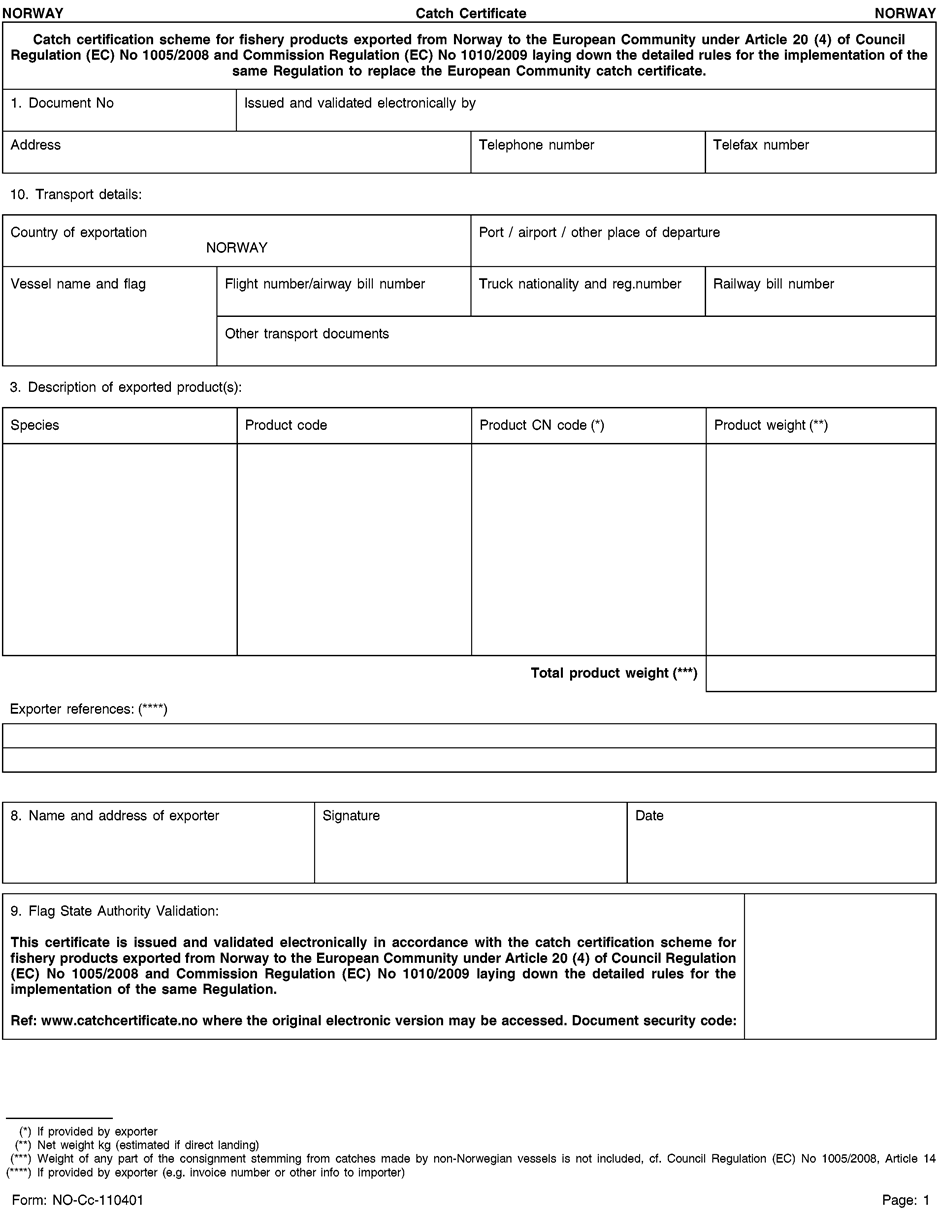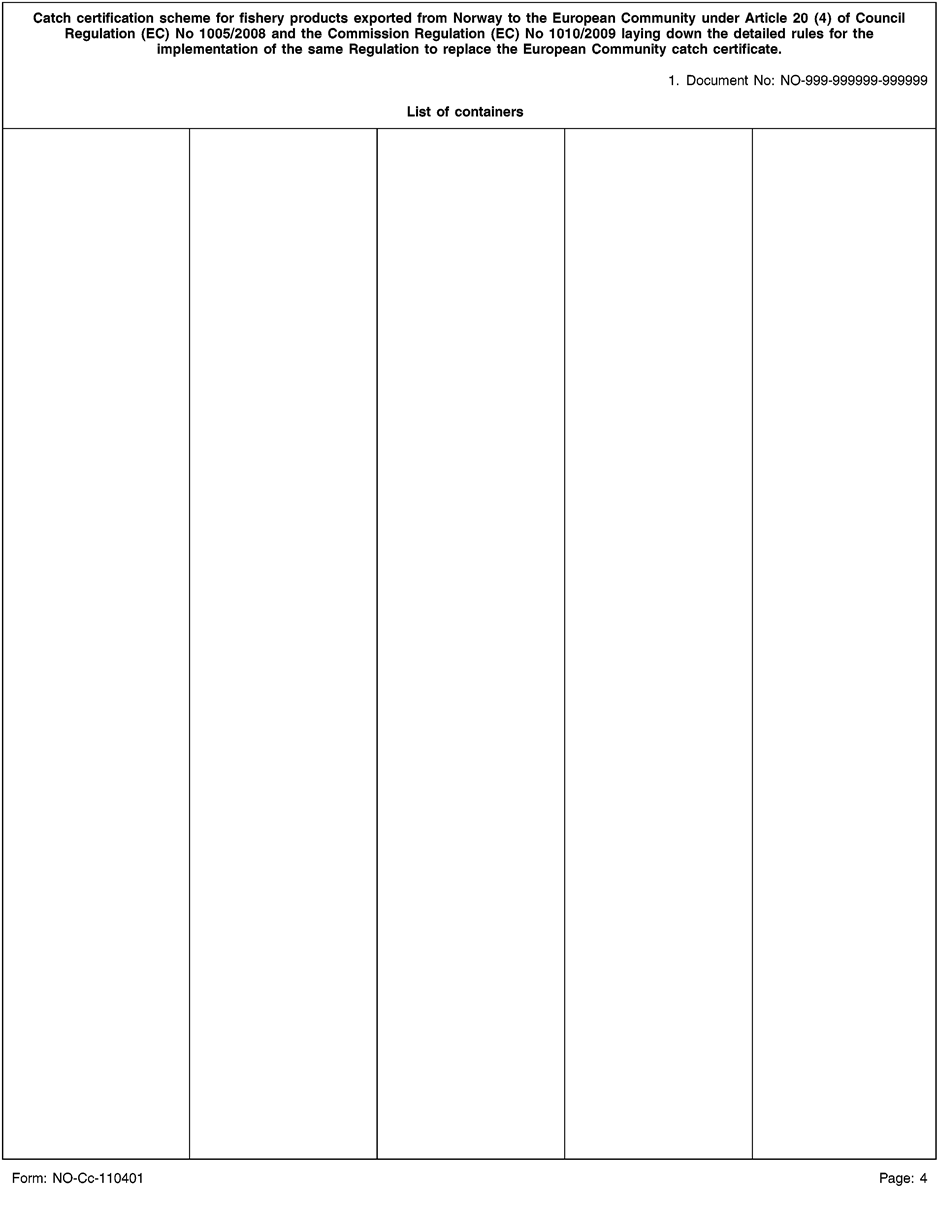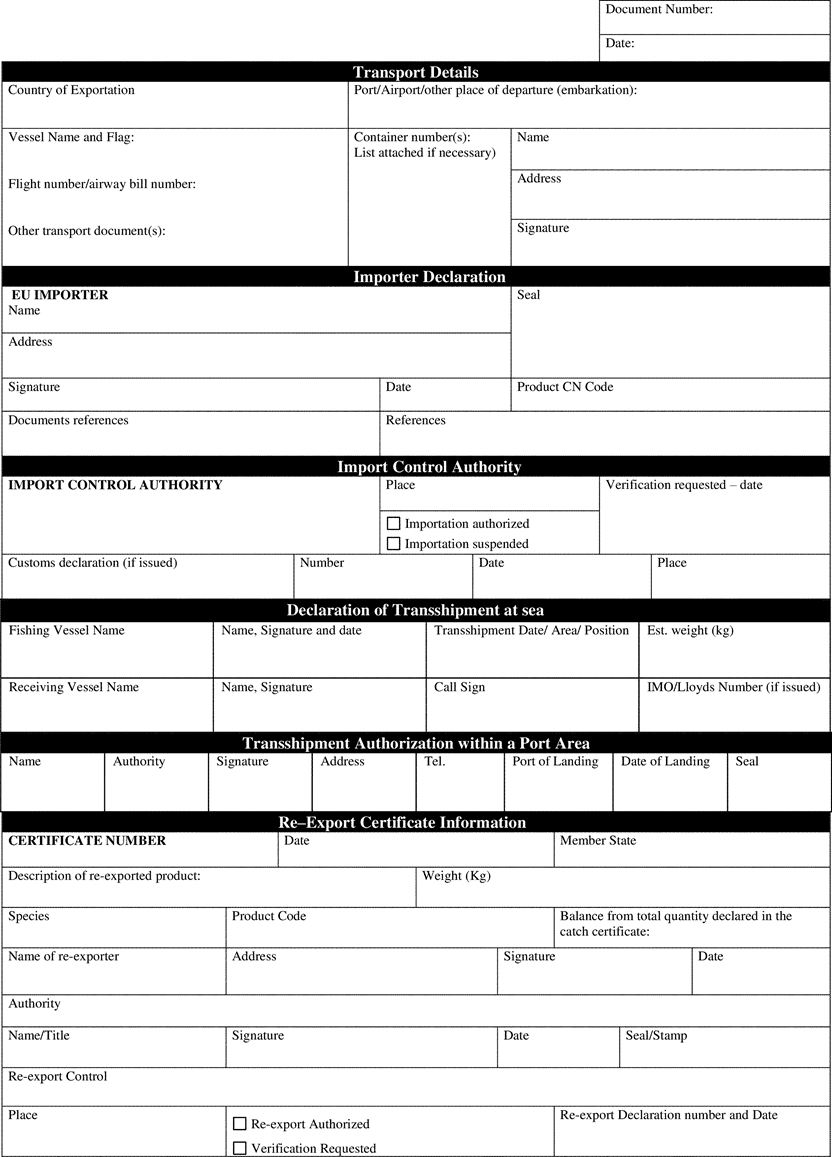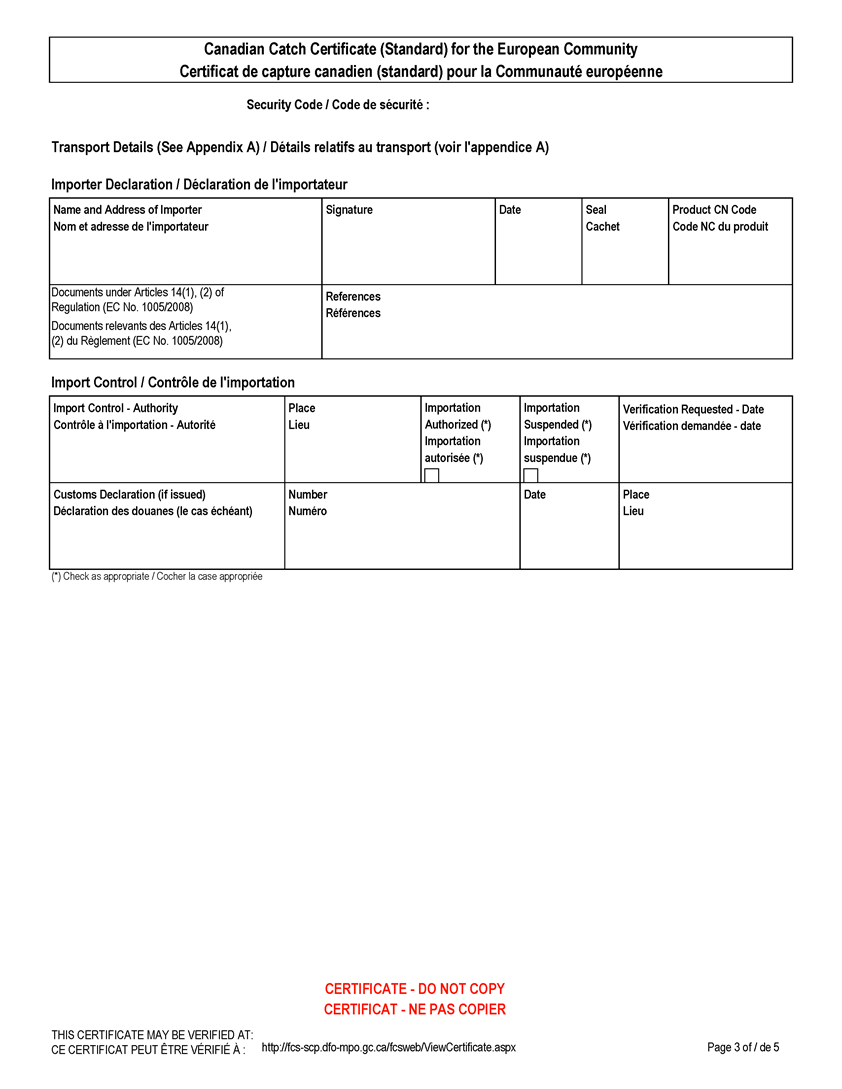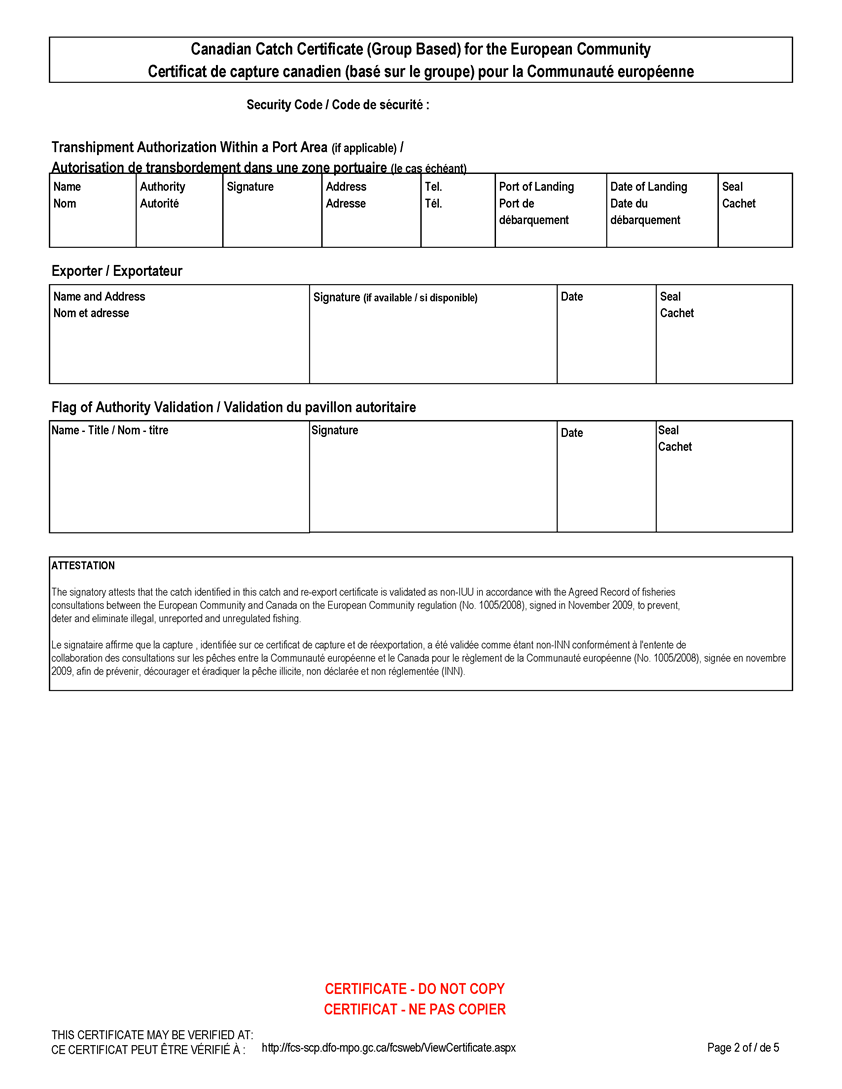ANNEX IXU.K. Administrative arrangement with flag States pertaining to the implementation of the catch certification provisions (Article 12(4) of Regulation (EC) No 1005/2008)
[F1 [F2Section 1 U.K. NORWAY
CATCH CERTIFICATION SCHEME U.K.
In accordance with Article 12(4) of Regulation (EC) No 1005/2008, the catch certificate provided for in Article 12 and Annex II of that Regulation shall be replaced — for fisheries products obtained from catches made by fishing vessels flying the Norwegian flag — by the Norwegian catch certificate, based on the Norwegian system on weighing and recording of catches, which is an electronic traceability system under the control of the Norwegian authorities ensuring the same level of control by authorities as required under the European Union catch certification scheme.
Specimens of the Norweigian catch certificate which shall replace the European Union Catch Certificate and Re-export Certificate and are given in Appendix I.
Documents referred to in Article 14(1) and (2) of Regulation (EC) No 1005/2008 may be communicated by electronic means.
Norway shall require a catch certificate for landings and imports to Norway of catches made by fishing vessels flying the flag of a Member State of the European Union.
MUTUAL ASSISTANCE U.K.
Mutual assistance under Article 51 of Regulation (EC) No 1005/2008 shall be developed to facilitate the exchange of information and the assistance between the respective authorities in Norway and in the Member States of the European Union, based on the detailed rules on mutual assistance laid down in Regulation (EC) No 1010/2009.
Appendix I] U.K.
Textual Amendments
F1 Inserted by Commission Regulation (EU) No 86/2010 of 29 January 2010 amending Annex I to Council Regulation (EC) No 1005/2008 as regards the definition of fishery products and amending Commission Regulation (EC) No 1010/2009 as regards exchange of information on inspections of third country vessels and administrative arrangements on catch certificates.
[F3Section 2 U.K. UNITED STATES
CATCH CERTIFICATION SCHEME U.K.
In accordance with Article 12(4) of Regulation (EC) No 1005/2008, the catch certificate provided for in Article 12 and Annex II of Regulation (EC) No 1005/2008 shall be replaced – for fisheries products obtained from catches made by fishing vessels flying the flag of the United States – by the U.S. catch certificate based on the U.S. Catch Certification System (described in Appendix 2) which is an electronic reporting and record keeping system under the control of the U.S. authorities ensuring the same level of control by authorities as required under the European Union catch certification scheme.
A specimen of the U.S. catch certificate, which shall replace the European Union Catch Certificate and Re-export Certificate, is provided in Appendix 1. This revised U.S. catch certificate may cover fisheries products obtained from catches made by single vessels or groups of vessels as described in Appendix 2.
MUTUAL ASSISTANCE U.K.
Mutual assistance under Article 51 of Regulation (EC) No 1005/2008 shall be developed to facilitate the exchange of information and administrative cooperation between respective competent authorities in the United States and Member States of the European Union, based on the detailed rules on mutual assistance laid down in Regulation (EC) No 1010/2009.
Appendix 1 U.K.
Appendix 2 U.K.
The U.S. Catch Documentation Scheme, as revised in 2019, is designed to issue a single form of catch certificate for export consignments from the United States to the European Union (EU) of fishery products, raw and processed.
On the U.S. catch certificate, U.S. exporters will be required to 1) list the single vessel responsible for the harvest of fish or fisheries products comprising the respective consignment with all of the applicable information required on the United States Attestation of Legal Catch; or 2) provide a vessel grouping name responsible for the harvest of fish or fisheries products comprising the respective consignment with all of the applicable information required on the United States Attestation of Legal Catch.
The grouping feature will be used for fisheries subject to significant commingling of catch at-sea or on-shore (for example, fisheries including but not limited to: those where initial catches are divided by size before further dispatch e.g., lobster; or those in which multiple harvest vessels deliver fish to tender vessels at sea).
Groupings will be managed by the U.S. producer or processor requesting the certificate and subject to audit. Reflecting current U.S. practices, the U.S. producer or processor will be responsible for retaining all information corresponding to the vessels or list of vessels which contributed to the consignment and providing that information to the U.S. Government competent authority upon request.
The single vessel or grouping feature will enable the United States to produce a single certificate per shipment while having access to the complete vessel information behind each shipment.
This information will be available to authorities in importing Member States upon request to the U.S. Government competent authority.]
Textual Amendments
Section 3 U.K. NEW ZEALAND
CATCH CERTIFICATION SCHEME U.K.
In accordance with Article 12(4) of Regulation (EC) No 1005/2008, the catch certificate provided for in Article 12 and Annex II of Regulation (EC) No 1005/2008 shall be replaced — for fisheries products obtained from catches made by fishing vessels flying the flag of New Zealand — by the New Zealand catch certificate, which is an electronic traceability and certification system under the control of the New Zealand authorities ensuring the same level of control by authorities as required under the Community catch certification scheme.
A specimen of the New Zealand catch certificate, which shall replace the European Community Catch Certificate and Re-export Certificate for catches by fishing vessels registered in New Zealand and which are landed in New Zealand from 1 January 2010 , is given in Appendix I.
Supporting explanatory notes on the New Zealand catch certificate are given in Appendix II.
Documents referred to in Article 14(1) and (2) of Regulation (EC) No 1005/2008 may be communicated by electronic means.
MUTUAL ASSISTANCE U.K.
Mutual assistance under Article 51 of Regulation (EC) No 1005/2008 shall be developed to facilitate the exchange of information and assistance between respective competent authorities in New Zealand and Member States of the European Community, based on detailed rules on mutual assistance laid down in Commission Regulation (EC) No 1010/2009.
Appendix I U.K.
Specimen of the New Zealand catch certificate U.K.
Appendix II U.K.
Supporting explanatory notes on the New Zealand catch certificate U.K.
The ‘ consignor ’ is the ‘ exporter ’
Any information included in an ‘ unofficial information ’ box and information that follows the New Zealand government signatures is not validated by the New Zealand government.
[F4Section 4 U.K. ICELAND
CATCH CERTIFICATION SCHEME U.K.
In accordance with Article 12(4) of Regulation (EC) No 1005/2008, the catch certificate provided for in Article 12 and Annex II to that Regulation shall, as of 1 January 2010 , be replaced — for fisheries products obtained from catches made by fishing vessels flying the Icelandic flag — by the Icelandic catch certificate, based on the Icelandic System on weighing and recording of catches, which is an electronic traceability system under the control of the Icelandic authorities ensuring the same level of control by authorities as required under the EU catch certification scheme.
A specimen of the Icelandic catch certificate is given in the Appendix.
Documents referred to in Article 14(1) and (2) of Regulation (EC) No 1005/2008 may be communicated by electronic means.
Iceland shall require a catch certificate for landings and imports to Iceland of catches made by fishing vessels flying the flag of a Member State of the European Union.
MUTUAL ASSISTANCE U.K.
Mutual assistance pursuant to Article 51 of Regulation (EC) No 1005/2008 shall be developed to facilitate the exchange of information and the assistance between the respective authorities in Iceland and in the Member States of the European Union, based on the detailed rules on mutual assistance laid down in Commission Regulation (EC) No 1010/2009.
Appendix U.K.
Textual Amendments
Section 5 U.K. CANADA
CATCH CERTIFICATION SCHEME U.K.
In accordance with Article 12(4) of Council Regulation (EC) No 1005/2008, the catch certificate provided for in Article 12 and Annex II to that Regulation shall be replaced — for fisheries products obtained from catches made by fishing vessels flying the flag of Canada — by Canadian catch certificates based on the Canadian Fisheries Certificate System (FCS) (described in Appendix 3), which is an electronic traceability system under the control of the Canadian authorities ensuring the same level of control by authorities as required under the EU catch certification scheme.
Specimens of the Canadian catch certificates which shall replace the European Community Catch Certificate and Re-export Certificate as from 1 January 2010 are given in Appendices 1 and 2.
Catches stemming from aboriginal fishing techniques or from fishing vessels as defined in Article 6 of Commission Regulation (EC) No 1010/2009 shall be accompanied by a simplified Canadian catch certificate given in Appendix 2.
Documents referred to in Article 14(1) and (2) of Regulation (EC) No 1005/2008 may be communicated by electronic means.
MUTUAL ASSISTANCE U.K.
Mutual assistance pursuant to Article 51 of Regulation (EC) No 1005/2008 shall be developed to facilitate the exchange of information and administrative cooperation between respective competent authorities in Canada and Member States of the European Union, based on detailed rules on mutual assistance laid down in Commission Regulation (EC) No 1010/2009.
Appendix 1 U.K.
Appendix 2 U.K.
Appendix 3 U.K.
The Canadian Fisheries Certificate System (FCS) is designed to issue standard and simplified catch certificates. U.K.
The FCS will be used to issue and to validate a catch certificate for export consignments from Canada to the European Union of conventional fishery products including live, fresh, frozen, salted, canned and/or smoked and dried fish, using raw material from non-vessel fisheries, aboriginal fisheries, or small and large fishing vessels and/or involving production comprising several steps in the production process.
On simplified certificates, Canada will group certain vessels to maximise efficiency. However, the FCS will maintain a complete link to vessels contained in groupings and these vessels are further linked to their license or registration information and the declared catch on the certificate.
The grouping feature will be used for some product forms and, in particular, for fisheries using collector vessels which purchase from several fishing vessels and issue records of sales at sea, for non-vessel fisheries such as beach seine, beach clams, ice fishing, for some inshore fisheries, and for aboriginal fisheries where fisheries may occur at the community level. Groupings will be export company-specific and will be modified for each shipment, as required.
The grouping feature will enable Canada to produce a single certificate per shipment while keeping all the information behind the certificate (vessel license/registration) available in the database.
This information will be available to EU Member States authorities in importing countries through our website or through direct telephone line to our certificate office.
Third parties countries may also contact the certificate office for information on indirect exports.
Section 6 U.K. FAROE ISLANDS
CATCH CERTIFICATION SCHEME U.K.
In accordance with Article 12(4) of Regulation (EC) No 1005/2008, the catch certificate provided for in Article 12 and Annex II to that Regulation shall be replaced — for fisheries products obtained from catches made by fishing vessels flying the Faroese flag — by the Faroese catch certificate based on the Faroese system of sales notes and logbooks which is a traceability system under the control of the Faroese authorities ensuring the same level of control by authorities as required under the EU catch certification scheme.
A specimen of the Faroese catch certificate, which shall replace the European Community Catch Certificates and Re-export Certificate as from 1 January 2010 , is given in the Appendix.
Documents referred to in Article 14(1) and (2) of Regulation (EC) No 1005/2008 may be communicated by electronic means.
MUTUAL ASSISTANCE U.K.
Mutual assistance pursuant to Article 51 of Regulation (EC) No 1005/2008 shall be developed to facilitate the exchange of information and assistance between respective competent authorities of the Faroe Islands and Member States of the European Union, based on detailed rules on mutual assistance laid down in Commission Regulation (EC) No 1010/2009.
Appendix] ] U.K.
[F5Section 7 U.K. SOUTH AFRICA
CATCH CERTIFICATION SCHEME U.K.
In accordance with Article 12(4) of Regulation (EC) No 1005/2008, the catch certificate provided for in Article 12 and Annex II of that Regulation shall be replaced — for fisheries products obtained from catches made by fishing vessels flying the flag of South Africa — by South African catch certificates, which is an electronic traceability system under the control of the South African authorities ensuring the same level of control by authorities as required under the European Union catch certification scheme.
Specimens of the South African catch certificates which shall replace the European Union Catch Certificate and Re-export Certificate and are given in Appendix I.
Documents referred to in Article 14(1) and (2) of Regulation (EC) No 1005/2008 may be communicated by electronic means.

